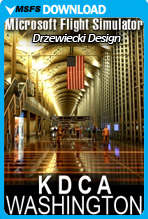SUMMARY
Reagan, Ronald Washington National Airport is in Arlington, Virginia, near the Washington, D.C. boundary. In 1998, Congress changed the name to commemorate President Ronald Reagan. Although Reagan National's tiny size limits its capacity, it presently serves 98 nonstop destinations. The South Hangar Line and the Washington National Airport Terminal were added to the National Register of Historic Places in 1997. There are five international trips currently scheduled, with destinations in Canada, the Bahamas, and Bermuda. The noise regulations at Reagan National Airport are among the most stringent in the country.
DETAIL
Ronald Reagan Washington National Airport (IATA: DCA, ICAO: KDCA, FAA LID: DCA) is in Arlington, Virginia, near the border of Washington, D.C. It has the airport codes DCA, KDCA, and DCA. It is the smaller of the two airports that serve the National Capital Region around Washington that are run by the Metropolitan Washington Airports Authority. The airport is 8 km (5 miles) from the center of Washington, D.C. Washington National Airport was the original name of the airport. In 1998, in honor of President Ronald Reagan, Congress changed the name to what it is now. In 2019, almost 24 million people used the airport.
In general, nonstop flights into or out of the airport can't go further than 1,250 statute miles (2,010 km) in any direction. This is so that coast-to-coast and international flights can go to Washington Dulles International Airport. There are 40 exceptions to this rule, called "slots." Planes have to take unusually complicated routes to avoid restricted and forbidden airspace above important landmarks, government buildings, and military installations in and around Washington, D.C., and to meet some of the strictest noise rules in the country.
The airport's small size limits how many people can use it at once, but Reagan National serves 98 nonstop destinations right now. American Airlines has a big hub there. The airport doesn't have any immigration or customs facilities for the United States. The only scheduled international flights at the airport are from airports with U.S. Customs and Border Protection preclearance facilities. This usually includes flights from major airports in Canada and some places in the Caribbean. Washington Dulles International Airport and Baltimore–Washington International Thurgood Marshall Airport are used for other international flights to the Washington, D.C. area. At the moment, there are five scheduled international routes to Canada, the Bahamas, and Bermuda.
In March 1967, runways 18–36 were the first at a civil airport in the United States to be grooved to help with traction when it was wet. In 1977, Metro service to the airport station began. In 1997, the National Register of Historic Places included the Washington National Airport Terminal and South Hangar Line.
Some of the strictest rules about noise in the country are in place at Reagan National Airport. Also, there is no airspace above 18,000 feet around the National Mall and U.S. Naval Observatory in central Washington because of security concerns (5,500 m). Because of these rules, pilots coming from the north usually have to follow the Potomac River and turn right before landing. The River Visual is the name for this method. In the same way, flights that take off to the north must quickly climb and turn left. The "River Visual" can only be done when the sky is at least 3,500 feet (1,100 m) high and you can see at least 3 statute miles (4.8 km) away. Pilots can follow the river with the help of lights on the Key Bridge, the Theodore Roosevelt Bridge, the Arlington Memorial Bridge, and the George Mason Memorial Bridge. When visibility or winds make it impossible to use the River Visual, planes can fly an offset localizer or GPS approach to Runway 19 along a similar path. Most planes are also able to land on the shorter Runway 15/33 using a VOR or GPS approach. There are also sometimes visual and ILS approaches from the north to Runway 1. These approaches follow the Potomac River from the south and fly over the Woodrow Wilson Bridge.
Scenery Features
-
High-quality model of KDCA Washington National airport, featuring the up-to-date version with extensive details throughout the whole airport
-
FPS-friendly design, with epic night textures, dynamic lighting, and PBR materials
-
Performance-friendly interior modeling at terminal buildings, control tower, and some hangars, static aircraft, advanced night lighting, custom animations, custom mesh, custom animated jetways
-
Designed to be perfectly compatible with Washington Landmarks MSFS by Drzewiecki Design
Requirements
-
Microsoft Flight Simulator (FS2020)
|

